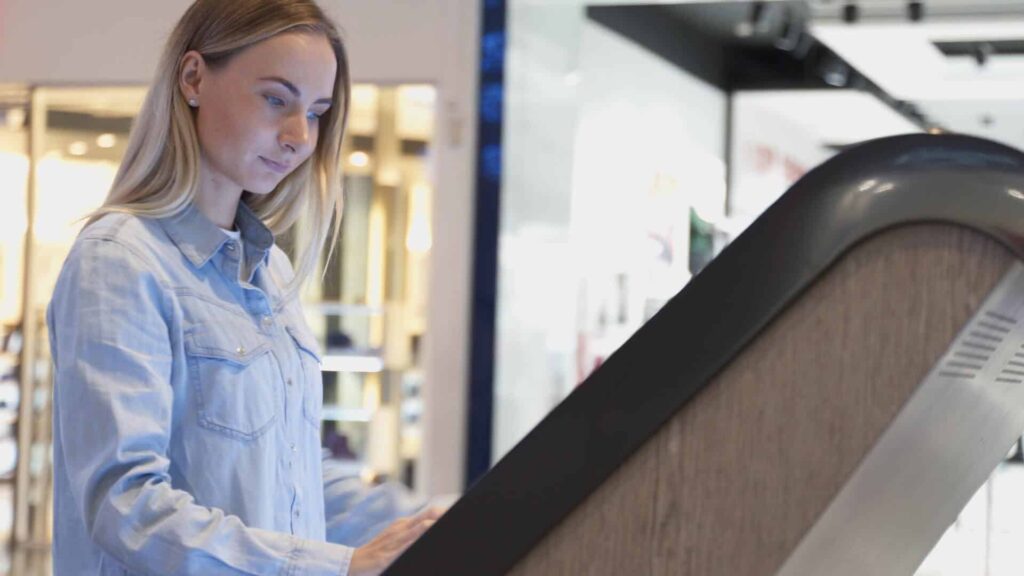Wayfinding kiosks are having a moment—and with good reason.
As companies adapt to the challenges of hybrid working, they’re discovering that old wayfinding systems can no longer meet the demands of dynamic (and often distributed) workplaces. Wayfinding kiosk solutions are proving to be a relatively simple way to cut through the noise.
In this article, we explore how wayfinding kiosks can play a critical role in an overarching new digital wayfinding system. We also look at the benefits of these systems and how to make them better.
First up, we’ll cover wayfinding in general and digital wayfinding specifically. We’ll be highlighting how interactive wayfinding can help companies and employees in a variety of ways.
What is wayfinding?
Wayfinding refers to all the tools and systems that help people navigate physical spaces. These can range from anything as simple as the ‘You Are Here’ maps we’ve all used in shopping malls, to complex and interactive systems available on smartphones, digital displays, wayfinding apps, and more.
In general, the larger or more complex a built environment, the more important wayfinding design becomes. This is why college campuses, healthcare centers, airports, smart cities, and other organizations with complex physical environments invest in extensive wayfinding signage systems and user interfaces.
It’s also why, as companies either return workers to the office and/or implement hybrid work, they are grappling with the overall wayfinding experience for their people.
Mental maps, and even actual (but static) maps are no longer enough to navigate spaces that you use infrequently. Or spaces that are constantly in flux. Where one team member sat today can be very different from where they sit tomorrow. Dynamic and/or distributed workforces therefore need to be able to access resources in real-time. This is why digital wayfinding systems are increasingly important

What is a digital wayfinding system?
Remember that a wayfinding system refers to all the resources that people can use to navigate space. So, like you would expect, ‘digital’ wayfinding systems simply add technology to this equation.
Through wayfinding software and integrations, digital displays, and mobile devices, a digital wayfinding system is usually able to provide people (including employees and visitors) a much better user/customer experience.
Digital wayfinding programs can easily include more accurate and real-time information than their traditional counterparts. They are also much more customizable, helping to support workplace agility and flexible work arrangements.
And in the physical office setting, digital wayfinding maps and information kiosks can move beyond simply showing ‘You Are Here,’ instead providing detailed, up-to-date information about a floor plan (and even the resources and people currently in it).
For example, Visual Directory, the digital directory available from OfficeSpace, moves beyond the simple functionality of directories available in the past. Available via mobile app, desktop, and/or through wayfinding kiosks, this directory is accurate down to the desk or chair. Individual employee moves are shown as they happen. And employees are also able to see the location of a variety of resources and amenities. Like printer rooms, first aid stations, and more.
Visual Directory also integrates with Who’s In. This is an incredibly popular tool that lets users see when and where their colleagues have booked time to work in the office. According to the 2023 OfficeSpace Workplace Strategy Report, over 90% of clients use this feature. This in large part to its ability to promote both ad hoc and formal collaboration in the workplace and enhance the overall experience of the space.
We’ll explore how the right digital wayfinding tools can be part of broader collaboration strategies in the workplace below.

What are wayfinding kiosks?
Digital wayfinding kiosks are the front end of a modern wayfinding system. Cloud-based, self-service wayfinding tools, they render floor plans and digital maps on an interactive touchscreen, that anyone can use to find their way around or locate what they need in real time.
In other words, wayfinding kiosks are a cutting-edge response to the drawbacks of traditional, static maps on the wall.
Wayfinding kiosks can take the form of dedicated custom kiosk hardware. That said, standalone iPads and wall-mounted touchscreens work equally well (with a typically lower price point).
Wayfinding kiosks can be especially useful for larger facilities and offices, and/or those that frequently change layouts, room functions and/or seating arrangements. They can also be useful in organizations with a large percentage of remote and hybrid workers. This is where people may use their facilities less frequently (and could therefore use an extra wayfinding ‘boost’ when in the office).
In this way, a dedicated kiosk can mean the difference between frustrated employees (and guests) who can’t find their way around, and empowered employees who can always access what and who they need, when they need it.
The right indoor mapping solution can have a demonstrably positive impact on your company’s performance.
Margot Soulier, Forbes

What are the benefits of using interactive wayfinding kiosks?
Digital self-service kiosks may seem like a small addition to the workplace, but they pack a big punch. Beyond simply highlighting the best route from Point A to Point B, good wayfinding solutions offer a variety of downstream (and often surprising) benefits to virtually everyone in a given space.
Consider one OfficeSpace client that introduced OfficeSpace-connected new kiosks, along with Slack integration, as part of a post-pandemic strategy to return to the office. With extremely large facilities and an extremely large percentage of new employees who had never been in them, their facility manager (FM) turned to kiosks integrated with a mobile app, which helped make the return as seamless as possible.
What she wasn’t expecting was to also see a boost in event attendance. As both new and returning employees gained confidence in their ability to get around, they started showing up to onsite events like never before.
“Now that we have interactive maps that are so clear and easy to read, people are showing up to events more than ever, because they can actually find them!” says the FM. “They can simply use their phone or Slack or a kiosk to find the people and places they need. It really helps with that engagement piece.”
Meanwhile, consider that 40% of employees can waste up to 30 minutes a day looking for meeting spaces. Clearly, not having good kiosks (and/or other digital wayfinding solutions) can lead to wasted time and wasted collaboration opportunities.
But beyond simply helping employees find their way around, the benefits of digital directory kiosks will depend on the people who use them.
Wayfinding kiosk benefits for new employees
Good wayfinding signs and kiosks go a long way in setting new employees up for success.
We’ve all been new to a job at some point. And among all the challenges for newbies, navigating the workplace doesn’t need to be one of them. When used properly, wayfinding technology can help make the onboarding process as painless as possible.
Specifically, new employees can use Visual Directory and Who’s In to see where they’ll be sitting, and who they’ll be sitting with, on their first day.
Then they can use kiosks and other integrations to manage crucial ‘firsts’. Like locating their manager and team members, exploring the office, and finding amenities.
Benefits for all employees
The most successful workplace teams are those that are able to connect and collaborate with their coworkers. In this light, things like kiosks and Who’s In can be seen as workplace collaboration tools. By helping groups find the spaces they need to work together, these tools can help iron out any obstacles to teamwork.
Meanwhile, all employees need to be able to find the types of workspaces that make them most productive. But as more employees are working hybrid, they may be less familiar with their facilities when they do come in.
Plus, more and more companies are experimenting with new office configurations. This is typically in an attempt to right-size their real estate portfolios and make them more efficient. We’re also currently experiencing a whole-hearted, industry-crossing embrace of flexible seating options (like hot desking and activity based working), all of which can change up the look and feel of the office each day.
So even more traditional workers who come in every day might still find themselves struggling to navigate a new office floor plan.
And of course, if you and your colleagues all have different hybrid schedules, how will you know when and where to find them in your new hybrid office?
In short, every employee today can use a helping hand to get around the office. By helping to improve employee experience overall, good wayfinding options play a role in talent attraction and retention efforts, along with workplace wellbeing and productivity.
Note that kiosks connected to OfficeSpace can also allow employees to search and find collaborative workspaces by capacity or by features (such as whether they support video conferencing). This in turn can help support overarching collaboration and culture efforts, which are top of mind for many hybrid leaders.
Benefits for space planners and facility managers
Presumably, a space planner or FM will already know their way around the office. But they too can benefit from the right digital wayfinding systems.
So while an FM might not need a kiosk to find an amenity or meeting room, they can still use kiosks and more to locate a specific employee who may be in a different seat each day.
Ideally, these wayfinding tools will also be integrated into a broader space management software system that collects data about when and where employees are using the workplace.
In the short term, this can help FMs with day-to-day workplace management solutions. Like knowing when to clean spaces or how much lunch to order.
In the long term, advanced workplace analytics provided by this software can provide insight into the efficiency and effectiveness of each area of the workplace. This in turn can help make better decisions to right-size corporate real estate, support hybrid workplace change strategies, or both.

What makes a good wayfinding system?
Effective wayfinding systems are those that are easy to use and easy to update. Good wayfinding systems will be digital (preferably available by mobile phone, too), interactive, accessible, and intuitive, helping to guide people simply and easily.
Wayfinding systems work best when they integrate with existing digital signage software and other wayfinding solutions (both hardware and software).
And smart companies understand that wayfinding signage and other environmental graphics (like wall murals and digital displays) can (and perhaps should) help reinforce brand messaging and company values. Everyone will see your digital wayfinding signage, so things like typography, experiential graphics, and graphic design matter.
Always remember the basic goal: to help people find their way, or find whatever they need, easily and efficiently. Are you creating an engaging workplace experience? Are you helping make your spaces more friendly and engaging?
In a modern office situation, this almost always means using wayfinding to help improve both the hybrid workplace and the employee experience.
What are the five principles of wayfinding?
To plan effective wayfinding systems, space planners usually draw from a framework consisting of the following five principles:
- Create a unique identity at each location, so users can immediately position themselves
- Use landmarks to provide orientation cues
- Create well-structured paths, with a beginning, middle, and end
- Create regions of differing visual character; while different regions may not have sharp boundaries, it should still be clear when you are ‘in’ an area, and when you are ‘out’
- Don’t give the user too many choices when navigating, i.e.: their best route forward should be clear
Digital kiosks can play a role in many of these categories. They can be landmarks that help create a unique identity. And they can certainly present users with one clear choice when navigating.
Note that these five wayfinding principles were first introduced by MIT research in 1998. They have since been widely applied in wayfinding application. Of course, when implementing a digital wayfinding system for the office, FMs and space planners will need to also consider a variety of other design elements if they want to truly enhance employee experience of the space.
For example, more modern wayfinding principles an FM might consider include interactivity, mobile-friendliness, and avoiding choice overload.
What are some examples of wayfinding?
We’ve all used Google maps, perhaps when trying to navigate a new city or find the spot where we’re meeting friends.
And like we’ve covered, many companies now use digital wayfinding systems to help their employees find and book desks.
Beyond this, some of the most common examples of wayfinding include:
- Physical signs, like pictograms, informational signs, reception signs, identification signs, street signs, and directional signs; note that placement is as important as signage design itself
- Meeting room digital signage
- Creative/branded room names
- Building directories and other forms of directories (like Visual Directory)
- Wayfinding kiosks
- Video walls
- Floor plans
- Area maps
The best wayfinding systems will layer a variety of these options. They should be providing interactive information to enhance both employee and visitor experience.
Use OfficeSpace on digital kiosks and more throughout your organization, to enhance your digital wayfinding system and improve employee experience. Reach out for a free demo.
Digital wayfinding FAQs
What is the purpose of wayfinding kiosks?
The purpose of wayfinding kiosks is to provide a physical touchpoint that people can use to help them navigate a space. Wayfinding kiosks can provide a host of real-time, accurate information. This makes them especially helpful in dynamic and/or large facilities, like airports, college and hospital campuses, and hybrid offices.
How are wayfinding kiosks used?
Wayfinding kiosks are used to enhance user experience in a physical space, by making wayfinding simple and accessible. Whether they are standalone hardware, or more simple iPads/touchscreen kiosks, people in a given space can use them to find the places, resources, and sometimes people they need. u003cbr/u003eu003cbr/u003eCompanies can also use wayfinding kiosks in broader design and branding efforts. Space planners may also add them to workplaces to enhance employee experience, especially in a u003ca href=u0022https://www.officespacesoftware.com/blog/what-is-a-hybrid-workplace/u0022 target=u0022_blanku0022 rel=u0022noreferrer noopeneru0022u003ehybrid workplaceu003c/au003e.
What is a digital wayfinder?
A digital wayfinding is any interactive display that can be used in wayfinding. It can be a wall-mounted touch screen or kiosk. Or a digital map that is accessible via mobile or desktop devices. A digital wayfinding kiosk is an example of a digital wayfinder.
What is the difference between wayfinding and navigation?
Wayfinding and navigating are similar yet distinct concepts. u003cbr/u003eu003cbr/u003eWayfinding is about the process of understanding and navigating a physical space. Common examples include wayfinding apps, wayfinding signage, and wayfinding kiosks that are common in large, built environments. u003cbr/u003eu003cbr/u003eMeanwhile, navigation is about the specific ways that people will reach their destination. This assumes that they have already used ‘wayfinding’ to determine where exactly that destination will be. Common examples of navigation include walking, hiking, driving, and boating.
Photos: Koh Sze Kiat, Martin Barraud, Viktoria Korobova, iryouchin, VioletaStoimenova




